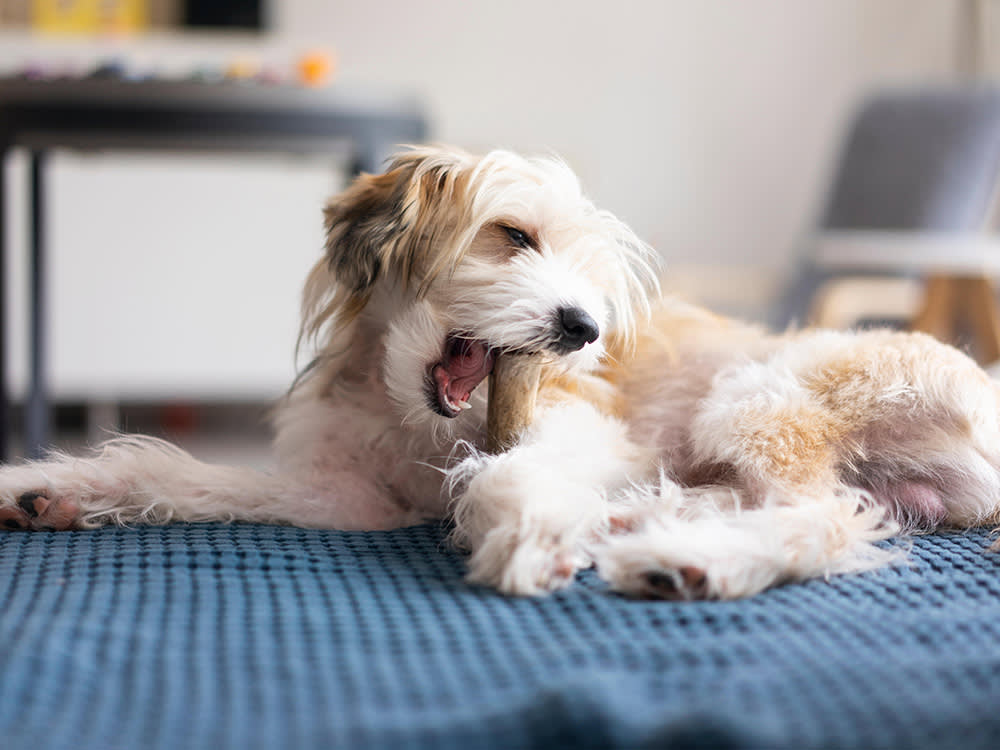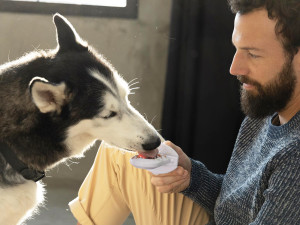Long-Lasting Chew Toys Are Key to Keeping Solo Dogs Happy
New research shows that chewing (toys, not shoes) reduces stress in dogs left home alone.
We all worry about leaving our dogs alone, even for short periods of isolation. We want to do what is best for them so they can be happy when we must leave them (to earn money to buy them things, for example!). Sure, there’s a part of us that knows the best way to keep them happy is simply to skip our obligations and take them out for a run or a hike or to hang out at home and play in the yard.
But what is the best way to keep them happy when we absolutely do have to head out without them, and they do have to stay alone? Plan A — never leaving our dogs — has great appeal, but a Plan B is essential. Recent research has found that long-lasting chew toys are a great way to keep pups busy when they they have to do some solo time at home.
Get (totally free) deals for food, treats, accessories, tech and way more pet parenting must-haves.
Long-lasting chews are a dog’s best friend, too
In a study published in Februaryopens in new tab, dogs stayed engaged with a long-lasting chew toy for longer than they stayed engaged with the other enrichment options. They also exhibited less stress and more positive emotions when they had a long-lasting chew, compared with when they were offered the other options.
Long-lasting chews were the most effective way to keep dogs engaged and in more positive emotional states with less stress than the other options in the study. The long-lasting chews were better than toys with food and automatically dispensed food, plus a voice from a person talking to them in a happy way.
Chew toys, food toys and automatic, food-dispensing toys
The study investigated the effects of different food-based enrichment options for dogs who were left alone to determine which kept them occupied for the longest time. The study also assessed which options keep dogs in the happiest state of mind so those alone times do not have to be so sad or stressful.
The researchers attempted to keep dogs happy by offering them a long-lasting chew, a Kong wobbler with kibble in it, and an automatic food-dispensing toy with kibble. The automatic food-dispensing toy was used in two ways: accompanied by a person’s voice and without a person’s voice.
A treat was delivered once a minute, whether or not there was a person talking to the dog. The voice was always a woman speaking in a high-pitched happy voice. She spoke before each treat was delivered, saying things like, “Hello, Max, are you being a good boy? Would you like a treat?” and “Guess what, I’ve got some more treats for you! Coming your way now!”
The experience of the dogs in the study
Researchers recorded video of 10 Labrador Retrievers and 10 Petit Basset Griffon Vendéens for 20 minutes with each of the enrichment options. The dogs in the study were each left alone four times so every dog had the opportunity to try all four of the options for enrichment in isolation. Experts watched the videos and recorded the emotional state of the dog throughout the experiment and the amount of time they stayed interested in the food or chew.
Future research
Dogs tend to like food and chew toys, but they don’t typically like being left alone, so exploring how to use the former to help make the latter easier is worth your while. Much more research needs to be done, though. I would like to know how long-lasting chews compare with a toy stuffed with really high-quality food such as chicken, steak, or peanut butter, instead of kibble for helping keep dogs happy when they are alone. I also want to know which long-lasting chews make dogs the happiest and keep them occupied when they must be alone.
It’s an exciting time to be a dog (and to have a dog) because scientists are studying what makes them happy and what we can do to keep their quality of life high. We don’t like leaving our dogs, but it’s a little easier when science lets us know what to do in that situation for the benefit of our dogs.









